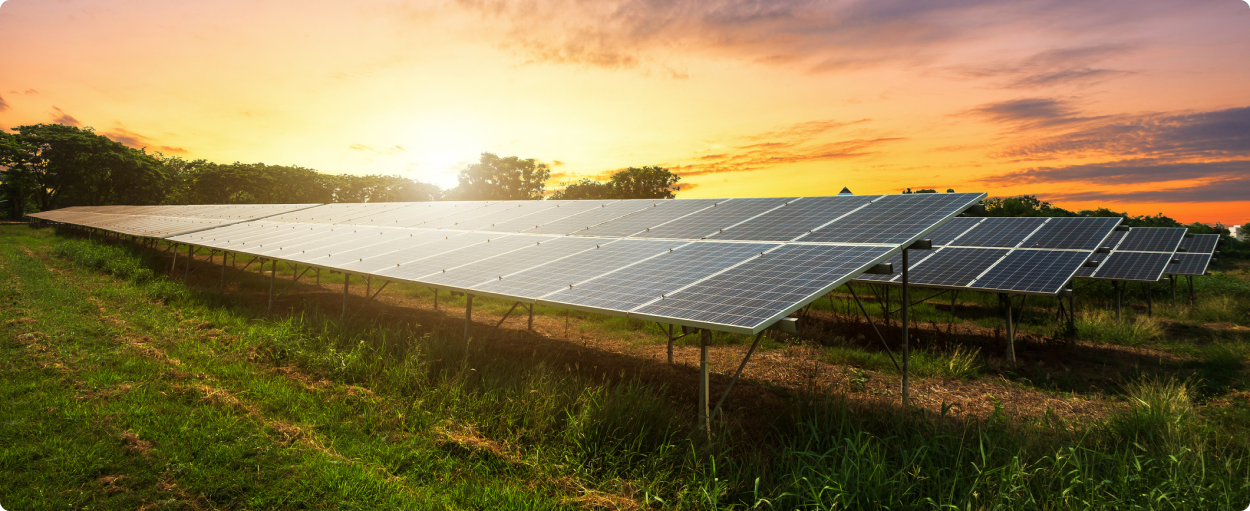

Commercial rooftop solar.
Commercial solar canopy.
Ground mount solar.
These are three of the top solar panel mounting methods a business might choose.
If your organization is interested in adopting solar as a renewable source of energy for your business, here’s a quick overview of each option to give your team a better sense of what to expect during the sales process.*
Commercial Rooftop Solar Mounting

Rooftop solar mounting is the most common option for commercial installations, but how it’s mounted depends entirely on the type of roof each business has. While there is a spectrum of roof types, some of the more common profiles include:

Flat-Top Roof Mounting
From big-box shopping centers and strip malls to office centers, multifamily and manufacturing plants, commercial and industrial solar applications are often found on large, flat rooftops.
This type of roof commonly utilizes a ballasted or hybrid mount system to secure the solar panels, and often does not require penetration to install. If penetrations are required, they are greatly reduced due to the ballasted securement of the array.

Metal or Corrugated Roof Mounting
Often found on small- to medium-sized commercial buildings, metal panels, standing seam metal and corrugated roofs typically require penetration to fasten solar panels.
Anchoring options include an “L-foot” bolt secured to the roof, or clamps that fasten to the metal ribs of the roof. There are, however, solutions for standing seam metal roofs that do not require any penetration.

Shingle Roof Mounting
While sloped shingle roofs are mainly found on residential solar installs, there are several smaller, standalone commercial properties and multifamily communities that fit the profile. Installing solar on these roofs generally requires flashing attachments that mechanically fasten the array beneath the shingles.
Rooftop space is a great location to install commercial solar panels, although there are many factors your solar technicians will consider during the assessment phase of a business, including age, geographical latitude, local weather conditions, roof slope, shading and more.
While potential damage to the roof is a common worry with rooftop solar customers, Sunnova provides a limited warranty that addresses workmanship and roof penetration.
Refer to the Limited Warranty agreement for complete warranty terms and limitations, including the specifications for energy retention over the life of the battery.
Is your business ready to start the process?
Commercial Solar Canopy Mounting

The commercial solar canopy — also known as a solar carport — is a mounting method that’s become increasingly popular with businesses. It involves installing solar panels on a canopy structure built over an existing parking lot, parking garage or outdoor space.
The top floor of a parking garage is a particularly common application for solar canopies since there is typically pre-existing electrical infrastructure that can sometimes be adapted for the install.
A canopy not only provides a business with commercial-grade solar energy, but it also provides shade to customers and employees who park their cars underneath the mounting structure. This helps reduce car temperatures in the hot sun and may help shield them from the weather.
Since panels on a canopy might be more visible compared to rooftop solar, they can potentially even be designed to match the branding style of the business.
A commercial solar canopy can convert a parking lot or garage into a power source, and employees and visitors alike could appreciate the convenient shade or shelter from the elements.
Want solar canopies for your business?
Ground Mount Solar

Commercial properties with available, unused land can install their solar panels on a frame or posts driven into the ground, as well as ballasted solutions to go over penetration-sensitive areas. This mounting method can potentially produce more energy since they can be more optimally tilted to capture maximum sunlight.
There are a few different types of ground mount solar systems, including:
Fixed Tilt Ground Mount
Solar panels are installed with a fixed, optimal tilt to capture sunlight. Commonly used for large commercial solar projects.
Solar Tracking System
Moves solar panels to follow the sun throughout the day. Can be installed in either a single or dual axis system. Ground-mounted commercial solar is ideal for organizations with lots of underutilized Greyfield or Greenfield land.

If you’re not sure which solar mounting method is right for your business, that’s ok. All you need to do is express interest to an energy provider like Sunnova, and a team of solar experts will take care of the rest — including researching factors like available space, optimal orientation, local weather patterns, shading, obstructions, latitude and more.
Sunnova has solutions to fit a variety of commercial solar installation types. Our team can design a system tailored to your energy needs and local utility rate structures to help meet your business goals.
Companies who purchase their commercial solar panels via loan or cash may be eligible to claim up to 30% of their system’s cost as a credit on their federal taxes.
We offer multiple fixed rate options and may recommend multiple mounting methods to ensure the system will produce at an optimal level.
You may be eligible for a federal tax credit with the purchase of a solar system. To qualify for the tax credit, you must have federal income tax liability at least equal to the value of the tax credit. Tax incentives are subject to change or termination by executive, legislative or regulatory action. Sunnova makes no guarantees regarding eligibility of any of the system’s costs for tax benefits. Sunnova does not provide tax advice. Contact your tax advisor for eligibility requirements.

